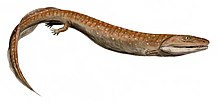厚蛙螈属
| 厚蛙螈属 化石时期:维宪期
~ | |
|---|---|

| |
| 科学分类 | |
| 界: | 动物界 Animalia |
| 门: | 脊索动物门 Chordata |
| 演化支: | 希望螈类 Elpistostegalia |
| 演化支: | 坚头类 Stegocephalia von Huene, 1948 |
| 属: | 厚蛙螈属 Crassigyrinus Watson, 1929 |
| 模式种 | |
| 苏格兰厚蛙螈 Crassigyrinus scoticus Watson, 1926
| |

厚蛙螈属(学名:Crassigyrinus,意为“粗壮的蝌蚪”)是已经灭绝的肉食性坚头类物种,栖息于石炭纪早期的苏格兰,而于西维吉尼亚州的格里尔也有发现疑似属于厚蛙螈的遗骸[1]。
发现史[编辑]
起先的样本缺乏头颅骨并命名为Macromerium scoticum,然而如今大部针对厚蛙螈的了解都是来自之后发现的三具颅骨化石,其中一具包含了完整的全身骨骼及两具不完整的下颚。厚蛙螈的体长可达2米(6英尺7英寸),具有大颚而四肢短小几乎退化。厚蛙螈的分类一直以来富有争议,其类似于鱼的身形与许多四足形的特征多年来困扰著众多古生物学家[2],传统上将厚蛙螈属与其他早期四足类一齐置于迷齿亚纲下,部分古生物学家则认为它们属于四足类冠群的最原始的基群,但也有部分古生物学家认为它们不属于四足类。
描述[编辑]
厚蛙螈体长可达2米(6英尺7英寸),身形为流线型。四肢短小几乎没有用处,显示厚蛙螈可能行完全水栖。四肢无法在地面行走,但可能可当作游动时的舵,或是在交配时用来攀附于异性上。厚蛙螈具有大颚,颚中具有两排牙齿,其中内排牙齿具有一对特别突出的獠牙,用以固定猎物。研究显示厚蛙螈可能有能力将上下颚张开至60度,在当时可能为具有极强咬合的掠食者[2]。这意味着厚蛙螈十分适合以鱼类为主食,且能快速游动于水中。


在厚蛙螈的头颅骨两眼间至口鼻部上长有骨质冠,古生物学家认为这些结构能够支持其在咬住猎物所需承受的压力。厚蛙螈具有大眼,可能为夜行性生物,或是生活在十分混浊的水中[3]。厚蛙螈同时也具有很大的耳凹,可能为气门而没有被鼓膜所覆盖[4]。
厚蛙螈粗短的前肢仅有35 mm(1.4英寸)长,肱骨表面上的神经孔分布与鱼石螈、棘螈、肉鳍鱼的真掌鳍鱼类似[5][6]。其后肢明显较前肢长,骨盆髂骨部分与脊椎并无直接连结(此特征常见于水生四足动物)。虽然厚蛙螈的四肢看似无用而随着演化逐渐退化消失[7],但有证据显示它们仍然会使用四肢来协助活动[8],证据在于在它们的四肢骨头上有发现受伤后愈合的痕迹[9],仍然保有愈合的能力意味着四肢对于厚蛙螈在某种程度上仍然是有用的,而非尚未退化完全的痕迹器官。纵使仅有发现少量尾部脊椎骨化石,科学家推测它们具有长而侧扁的尾巴,适合在水中游动或是瞬间推进爆发(类似现今的鳄鱼)[2]。厚蛙螈的生活形式可能类似现存的狗鱼,以伏击的形式捕捉游过的猎物。
一具受挤压变形的颅骨化石于1985年在考登比斯附近的朵拉骨层中发现,并由班禅发表[5],该化石于2023年由波洛等人重新取出分析,并透过电脑断层扫描以数位形式重建其颅骨外型。1985年当时的复原结果认为厚蛙螈具有较当时大多数四足类高而窄的头颅,然而2023年重建后的结果显示厚蛙螈的颅骨形状其实与其他早期四足类一样宽而扁平[10]。
下属物种[编辑]
本属包括以下物种:[11]
大众文化[编辑]
在2006年的《史前公园》第5集中出现,被奈吉尔·马文潜入水中并抓住,然而由于没有适合的运输装备运回史前公园因此只得放回。
外部链接[编辑]
参考文献[编辑]
- ^ Godfrey, S. J. 1988. Isolated tetrapod remains from the Carboniferous of West Virginia. Kirtlandia 43, 27-36.
- ^ 2.0 2.1 2.2 Chapter on Crassigyrinus (页面存档备份,存于互联网档案馆) from Gaining ground: the origin and evolution of tetrapods, by Jennifer A. Clack, Indiana University Press 2002, from Google Books
- ^ Palmer, D. (编). The Marshall Illustrated Encyclopedia of Dinosaurs and Prehistoric Animals. London: Marshall Editions. 1999: 51. ISBN 1-84028-152-9.
- ^ Benton, 2005. Vertebrate Palaeontology 3rd edition. Blackwell Publishing
- ^ 5.0 5.1 Panchen, A. L. 1985. On the amphibian Crassigyrinus scoticus Watson from the Carboniferous of Scotland. Philosophical Transactions of the Royal Society of London B 309, 505-568.
- ^ Panchen, A. L. 1991. The early tetrapods: classification and the shapes of cladograms. In Schultze, H.-P. & Trueb, L. (eds) Origins of the Higher Groups of Tetrapods, Controversy and Consensus. Comstock/Cornell University Press (Ithaca and London), pp. 110-144.
- ^ Caldwell, Michael W. "Without a leg to stand on": on the evolution and development of axial elongation and limblessness in tetrapods. Canadian Journal of Earth Sciences. 2003-04-01, 40 (4): 573–588. Bibcode:2003CaJES..40..573C. ISSN 0008-4077. doi:10.1139/e02-081.
- ^ Lennie, Kendra I.; Mansky, Chris F.; Anderson, Jason S. New Crassigyrinus-like fibula from the Tournaisian (earliest Carboniferous) of Nova Scotia. Canadian Journal of Earth Sciences. 2020-10-13, 57 (11): 1365–1369 [2023-06-21]. Bibcode:2020CaJES..57.1365L. S2CID 225160164. doi:10.1139/cjes-2019-0128. (原始内容存档于2022-10-28) (英语).
- ^ Herbst, Eva C.; Doube, Michael; Smithson, Timothy R.; Clack, Jennifer A.; Hutchinson, John R. Bony lesions in early tetrapods and the evolution of mineralized tissue repair. Paleobiology. September 2019, 45 (4): 676–697. Bibcode:2019Pbio...45..676H. ISSN 0094-8373. S2CID 204145235. doi:10.1017/pab.2019.31
 (英语).
(英语).
- ^ Porro, Laura B.; Rayfield, Emily J.; Clack, Jennifer A. Computed tomography and three-dimensional reconstruction of the skull of the stem tetrapod Crassigyrinus scoticus Watson, 1929. Journal of Vertebrate Paleontology. 2023-05-02: e2183134. ISSN 0272-4634. S2CID 258475146. doi:10.1080/02724634.2023.2183134.
- ^ Crassigyrinus Watson, 1926. GBIF. [2023-05-23]. (原始内容存档于2023-04-01).
- ^ Laura B. Porro, Emily J. Rayfield and Jennifer A. Clack. 2023. Computed Tomography and Three-dimensional Reconstruction of the Skull of the Stem Tetrapod Crassigyrinus scoticus Watson, 1929. Journal of Vertebrate Paleontology. e2183134. DOI: 10.1080/02724634.2023.2183134,http://twitter.com/LauraBPorro/status/1653359347143983105,https://www.nhm.ac.uk/discover/news/2023/may/crushed-scottish-fossils-reconstructed-reveal-ancient-predators-skull.html
| |||||||||||||||||||||||||||||||||||||||||||||||||||||||||||||||||||||||||||||||||||||||||||||||||||||||||||||||||||||||||||||||||||||||||||||||||||||||||||||||||||||||||||||||||||||||||||||||||||||||
|






